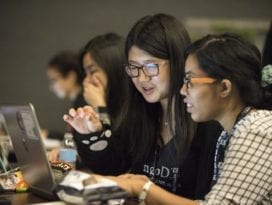GHC16 got off to a great start early Wednesday morning, with an impressive line-up of speakers for the opening keynote session. First off the bat was Telle Whitney, President of ABI. She remembered organizing the very first GHC in 1994 with Anita Borg. Back then, there were 500 attendees. GHC has grown by leaps and bounds in the intervening years, with nearly 15.000 women in tech attending the conference this year!
Next up was Dr. Latanya Sweeney, the founder and director of Harvard’s Data Privacy Lab, and former Chief Technologist of the Federal Trade Commission. She was also the very first African-American woman to graduate with a PhD in Computer Science from MIT.
Dr. Sweeney’s talk focused on how technology impacts humans and dictates our civic future. The environment in which computers operate has changed radically over the past few decades, so much so that it now encompasses the governance of daily life around the world. When the Sony camcorder was first introduced in 1983, American laws decreed that conversations couldn’t be recorded without the person’s consent. So while one now had the ability to record audio using the camcorder, it was against the grain of the law to do so. Fast forward to today, and the ability to record photos, video and audio is present in virtually every device.
We now live in a technocracy – tech design determines how we live our lives. Mattress sensors are capable of measuring our sleep patterns, and that data is sent to a third party to show us how well we slept at night. The Apple Watch captures and provides all kinds of data – how much you walked, when you need to exercise, and so on. All of this data is shared with your phone.
Dr. Sweeney explained how she first got into the field of data privacy. In grad school, she discovered that matching a person’s medical records to their voter ID records was relatively easy. This was the beginning of work that led to the HIPAA regulations. Several years later, she found that Googling “Latanya” showed her more images of African-American women, while googling “Tanya” gave her images of Caucasian women. Given that Google’s algorithm is supposed to be impartial, this just didn’t seem right.
After her stint at the FTC, Dr. Sweeney started a course called “Data Science to Save the World” at Harvard. With the first batch of students on the course, she also started publication of the “Journal of Technology Science”. There were several interesting papers written by the students – for example, one student was able to come up with a method of detecting fraudulent websites using Twitter. Another was able to establish price discrimination in the Princeton Review’s online SAT tutoring service – areas with high concentration of Asian families were likely to be charged higher. A third student found that Facebook Messenger dropped a user’s geo-location by default every time a message was sent, and this information was available to everyone. Eventually, Facebook released a patch to ensure that this information is shared only with user consent.
This year, Dr, Sweeney’s group is looking into voting data – at the moment, its surprisingly hard to find out where one needs to go to vote. They’ve even been able to find erroneous data given out on some NY and NC voting locations.
Dr. Sweeney firmly believes that given the vast amount of data available to us today, each of us can save the world.












